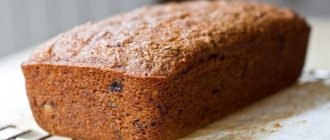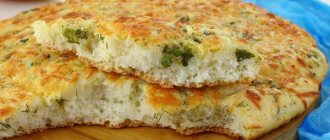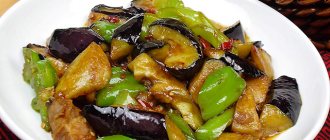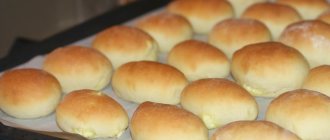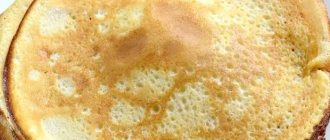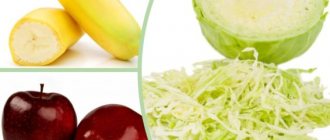How to prepare ciabatta
The original recipe, of course, is known to the inventor. By the way, Cavallari copyrighted it and registered the name. If you are in Italy, in the town of Bottrige, you can attend Arnaldo’s master class and see with your own eyes the birth of real ciabatta (and remember the technology, of course).
Classic ciabatta
water – 330 g salt – teaspoon dry yeast – eighth of a teaspoon high protein flour – 250 g semolina – 150 g olive oil – 1 teaspoon
The dough is kneaded with a mixer at high speed for 10-20 minutes (this is an important part of the process) and left to ferment in a warm place, covered with film. Fermentation should last 10-12 hours, and readiness is determined by the moment of its maximum rise. As soon as the level of the dough begins to decrease, the ciabatta must be prepared for baking, otherwise the dough will ferment and the bread will fail.
From the container in which the dough was proofed, it is transferred to a table well sprinkled with flour, or even better, semolina. Divide into two parts (do not knead the dough, work carefully with it as it is!). After a half-hour rest, the pieces are transferred to a baking sheet with parchment and placed in a hot oven.
You need to maintain humidity inside the oven so that the crust dries slowly and remains thin.
The bread is baked for 30-35 minutes, and the finished ciabatta produces a characteristic dull sound when tapped.
Fermented dough gives the bread a noble, slightly sour “homemade” taste and aroma.
By the way, our Russian cabbage soup with fresh cabbage goes perfectly with this wonderful Italian bread. Great lunch with a mix of styles!
Quick ciabatta at home, simple recipe
- 225 g water;
- 300 g flour (with a protein content of at least 13%);
- salt – 1.25 tsp;
- dry yeast – 1 tsp.
All ingredients are poured into the bowl of a food processor or mixed in a bowl suitable for using a mixer. Knead the dough at high speed for about 20 minutes. Intensive kneading greatly changes the structure of the dough. If at first it turns out to be liquid, then by the end of the kneading it becomes thick and very elastic, literally wrapped around the blades and collected towards the center of the bowl.
The dough is allowed to rise in a warm place under film. The duration of fermentation depends on the yeast - the finished dough should become liquid again and begin to bubble strongly. The further baking procedure is the same as for classic ciabatta. Important details:
- The preparations are placed on a heated baking sheet.
- To maintain the required humidity, place a container of water on the bottom of the oven. The sooner you remove the water, the thicker the crust will be.
- Semolina is crushed wheat kernels. It differs from semolina in that it is made from durum wheat. If you don’t have semolina, you can use semolina, although this will be a small deviation from the original recipe.
- Overcooked dough does not rise well in the oven. When preparing bread according to the classic recipe, do not miss the moment of highest rise.
- Do not reduce the kneading time - this significantly reduces the quality of the finished bread. High protein content in flour (strong flour) is 13% or higher.
- There is little yeast in the classic ciabatta recipe. This is not a mistake, but a consideration of the fact that the dough will ferment for a long time.
Cooking with sourdough
List of components:
- 2 tbsp. l. sourdough;
- 350 ml water;
- 400 g wheat flour;
- 1 tsp. Sahara;
- 1.5 tsp. salt.
Cooking method:
- Mix the starter and 80 ml of drinking water, 3 tbsp. l. with a heap of sifted flour. Get a liquid dough.
- Cover the mass with film and leave in a warm place until it rises (about 1.5 hours).
- Then add salt, sugar and the remaining flour. Knead all this with a mixer, gradually adding drinking water. The dough should not be very liquid, but not too stiff.
- Cover the product again with film and put it in a warm place for half an hour.
- Next, use the already familiar technique: fold the dough into an envelope (don’t be alarmed if it sticks), leave for 40 minutes. Repeat the process a total of 4-5 times.
- Take a sheet of parchment that is larger than the borders of the baking sheet. Form two rectangular “nests” out of paper, place on a metal sheet, and sprinkle them well with flour.
- Divide the semi-liquid mass equally and place the parts into the resulting “nests”.
- Lightly sprinkle flour on top, “pick up” the dough from the sides, if it has spread, leave in this state for 45 minutes.
- Preheat the oven to 220°C, place the future bread in it for a quarter of an hour.
- Reduce the oven temperature to 180 degrees and continue the process for another quarter of an hour.
Cool the product before serving, wrapping the baked goods in a towel.
Quick ciabatta with regular flour
And also about how to cook ciabatta at home in the oven - the use of “strong” flour is an important feature in the recipe for this bread. But if you don’t find it on sale, you can make ciabatta with regular wheat flour. In this case, the pulp will be a little less elastic, and the pores may turn out smaller, but if you repeat the entire technology exactly (long kneading with a mixer, proofing the dough until a large number of bubbles appear, carefully handling the workpieces and baking in a well-heated oven so that a crust quickly forms ), then you will still get ciabatta - tall bread with large pores and a crispy crust.
- 225 g water;
- 300 g flour (with a protein content of at least 13%);
- salt – 1.25 tsp;
- dry yeast – 1 tsp.
Making homemade ciabatta
Place ingredients into mixer bowl.
Turn on the dough kneading mode at maximum speed. At first the dough will be liquid.
Mix the dough at maximum speed for at least 10 minutes. After this it will become very viscous.
Leave to proof under the film until large bubbles appear. Transfer to a surface dusted with the semolina flour mixture (or semolina).
Form oblong loaves without kneading the dough (sprinkle with semolina on all sides), leave them for 30 minutes and transfer to a hot baking sheet. Bake in a preheated oven at 250-300 C for 5 minutes, then reduce the temperature to 200. Place a plate of water in the oven. Until ready. This bread goes well with cheese, olives or a salad of fresh vegetables.
So, we have already mastered ciabatta at home in the oven; the recipe with photos will help you bake this delicious bread and delight your household! Bon appetit!
Ciabatta: a classic Italian recipe
For the dough (sourdough) you will need:
- 100 g flour (baking flour);
- 30 g sugar;
- 200 ml warm water;
- dry yeast at the rate of (11 g per 1 kg of flour).
Main ingredients:
- 425 ml warm water;
- 1 tbsp. l. without a hill of salt;
- 900 g flour (baking flour);
- 50 g olive oil.
Bread filling:
- fried onions;
- sun-dried tomatoes and capers;
- olives or black olives to taste;
- dried herbs (basil, oregano)
First you need to prepare the dough (sourdough). To do this, mix all the ingredients specified in the recipe for the dough in one bowl. Leave in a warm place for 12 hours for the dough to rise. The bowl will need to be covered with a simple cotton towel to prevent a crust from forming on the surface and to ensure air access. After 12 hours, the dough will be ready and you can use it to knead the ciabatta dough.
To do this, gradually introduce the main ingredients into the dough and knead the dough. You need to knead it until it stops sticking to your hands. The resulting dough must be greased with olive oil and left to rest, wrapped in plastic wrap, for 10-15 minutes. In the meantime, you can prepare the filling.
Classic Italian ciabatta includes several fillings:
- Finely chopped white onions fried in olive oil.
- Small cubes of sun-dried tomatoes and capers.
- Quartered olives or pitted olives.
The filling is seasoned with dry Italian herbs of basil and oregano. It must be chilled. Hot water should not be added to the dough, because the yeast in it may die, and then your bread will not rise during baking.
Add the filling to the rested dough and mix well. The consistency of the dough should be homogeneous.
You need to bake in an oven preheated to 200°C for 10 minutes, then reduce the temperature to 180°C and continue baking the bread for another 20-25 minutes. Once the ciabatta is baked, remove it from the oven and let it cool at room temperature. Be sure to cover the finished bread with a towel to soften the crust.
Italian bread made with sourdough is incredibly tasty and healthy. You can eat ciabatta with various sauces, snacks or just with milk.
Ciabatta history. History of ciabatta
One of the most curious facts in the history of bread is that the familiar ciabatta was invented quite recently. Yes Yes! Contrary to popular belief, Italian ciabatta is a very young creation. But, one way or another, the history of traditional ciabatta, seemingly ancient, dates back only a few decades.
And not only that, the ciabatta recipe is most likely younger than our parents. The name of the inventor of this bread is also known. Not many people know, but 4-time Italian auto racing champion and future miller Arnaldo Cavallari had a hand in the birth of ciabatta. The professional racing driver, after leaving the big sport, finally went into “household chores.” Turned to what he loved, he began a series of experiments with baking bread at his bakery in the Italian town of Adria, Veneto province.
You can guess how much flour and wood Arnaldo burned during his baking experiments. But very soon, in 1982, he baked incredibly beautiful, airy and aromatic bread. The bread, which is called ciabatta due to its slipper-shaped shape. After all, it is the house slipper that is translated into Italian as “Ciabatta”
In case you are a ciabatta fan, you can easily pay your respects to Arnaldo on his Facebook page. Considering that he is a fairly sociable and positive person, in personal communication with the master it is possible to discover some subtleties in the ciabatta recipe. It is no secret that Arnaldo Cavalari is currently producing his own brand of flour and continues to actively promote the ciabatta recipe. In this regard, he is happy to answer questions.
As I wrote in mistakes when baking ciabatta, the main task when baking ciabatta comes down to kneading a very thin dough. As Arnaldo says, a very “wet” dough. It is also important to ensure the presence of water in the oven during baking. It doesn’t matter whether you spray it there, water it with a hose, or just put a tray of water on the bottom shelf. In this case, the predominance of water over flour has almost no analogues, but in the ciabatta recipe, as Arnaldo says, water generally plays a dominant role.
If you have already prepared a French baguette, which, like ciabatta, requires a huge amount of water throughout its preparation, then you have probably noticed the similarity of the recipes for baguette and ciabatta. In such cases they say, if there is not enough water, you won’t get bread! I had a suspicion that ciabatta was born from Arnaldo not without jealousy of the glory of the French baguette. In response to such a question, the Italian miller diplomatically laughs it off:
“Using a thin, very wet dough, I bake the best bread in the world! This is the most delicious bread because it is baked exclusively from natural ingredients. And I'm flying in the clouds with how good this bread is. I didn’t hesitate for a minute when choosing a name for it. Due to the fact that the bread turned out to look like house slippers, I named it Ciabatta. In 1989, I registered the trademark for the best bread, Ciabatta Italiana.
Ciabatta in the Pantheon multicooker
The multicooker comes to the aid of the housewife almost every day. A recipe in which you can make your own Italian ciabatta bread in a slow cooker is here for your attention.
You need to prepare:
- a quarter kilogram of flour (you can use whole grain flour, this will make the bread healthier and the crust a little tougher);
- a teaspoon of yeast;
- water 2 glasses;
- olive oil 60 ml;
- a tablespoon of sugar;
- a tablespoon of salt.
Your action plan should be like this:
- Pour yeast, salt and sugar into a deep bowl. Dilute with lukewarm water and knead until smooth. Gradually add flour a little at a time and knead. Leave in a warm place for 12 hours.
- After the dough has fermented, take it out and mix with a wooden spatula from the edges to the center. The dough is sticky, but the results are worth the hassle.
- Close the dough again and leave for 6 hours in a warm place.
- Take the dough out onto a floured board again and knead it gently.
- Grease the inside of the multicooker with oil, preferably olive oil. If the aroma of Italy does not inspire you, feel free to take our native domestic vegetable oil.
- Place the dough in the slow cooker, cover with a lid and leave to rest for another 4 hours. During this time, the number of bubbles will increase, the bread will be airier and lighter.
- Turn on the machine to the “Baking” mode for an hour and a half.
- Take out the bread, turn it over and put it back on “Baking” for half an hour.
Simple recipes with ciabatta
Recipes with ciabatta are simple and unpretentious, for example, you can cook:
- Sandwiches with ciabatta, porcini mushrooms and arugula.
- Fry the mushrooms, place on a ciabatta block, sprinkle with arugula and thin Parmesan cheese on top.
- Bruschetta with tomato and basil.
- Fry the ciabatta pieces, cut them and rub with a clove of garlic. Place peeled tomato and basil on top.
- Hot sandwich “Russians in Italy” - Cut a quarter of the loaf into a pocket, put sausage, cheese, and tomato inside. Dip the sandwich in beaten egg and fry in a frying pan.
Option for those who are fasting
To prepare a lean loaf you will need:
- 0.3 kg flour;
- 185 ml water;
- 5 g yeast;
- 15 ml sunflower oil;
- 15 g premium rye flour;
- 12 g salt.
Cooking method:
- Knead the dough from wheat flour and cold water and leave to rise for an hour.
- Add salt, yeast and oil to the product, mix until an elastic mass is obtained.
- Grease a tall baking dish, place the dough in it, and let stand for 60 minutes.
- Repeat the kneading of the risen mass, take a break for an hour, knead the dough again, then leave it at rest.
- After 60 minutes, sprinkle the table with flour, arrange the fluffy product in parts of 250 g each, and place on a baking sheet.
- Place in the oven for ¾ hour, bake at 40 degrees and 30% humidity. 5 minutes before the end of the process, increase this indicator to 100%.
- Increase oven heat to 260 degrees and continue cooking bread for 13 minutes.
- Now reduce the temperature to 180, open the door slightly, bake for another 5 minutes.
Cool the finished baked goods on a wire rack.


